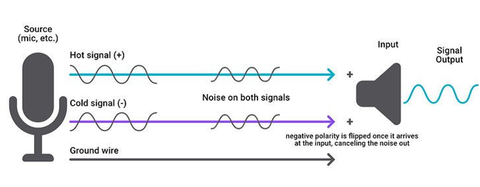Difference Between Balanced and Unbalanced Audio
Difference Between Balanced and Unbalanced Audio
One of the major differences between these cables is that balanced audio has less risk for unwanted noise, while unbalanced audio can pick up humming or buzzing sounds in certain environments.
In general, balanced audio will give you a better, stronger audio signal without any extraneous noises. Unbalanced audio, on the other hand, is susceptible to picking up noise and interference over longer distances. The ground wire in an unbalanced audio cable can pick up unwanted noise as the audio signal travels through it. This susceptibility (or lack thereof) to interference is due to how the cable is made.
To understand that, let's dive deeper into how balanced and unbalanced audio works.
What Is Balanced Audio?
The structure of a balanced audio cable is similar to an unbalanced cable — with one addition. A balanced audio cable has a ground wire, but it also carries two copies of the same incoming audio signal, sometimes referred to as a hot (positive) and cold (negative) signal.
What’s the difference between the hot and cold signals?
The two signals are reversed in polarity, so as they travel down the cable, they cancel each other out. (Think of how adding positive and negative numbers of equal value amounts to zero.)

Once the hot and cold signal get to the other end of the cable, however, the polarity of the cold signal is flipped, so both signals are in phase, and perfectly in sync.
Here’s the cool part: If the cable picks up noise along the way, the noise added to both of those cables is not reversed in polarity. So when the cold signal flips in polarity to match the polarity of the hot signal, the noise carried along the cold signal cancels out with noise in the hot signal. This canceling out process is called common-mode rejection, with the noise being the common signal between the two.
Because balanced signals send two in-phase signals, they’re also louder (roughly 6–10 dB) than what unbalanced signals can provide.
Balanced Cable Types---XLR
XLR cables can send balanced audio signals up to 200 feet. As you see in the diagram below, there are three male pins inside the connector: the groundwire, the hot signal, and the cold signal.

What Is Unbalanced Audio?
An audio cable carrying an unbalanced signal uses two wires: a signal and a ground.
The signal wire, as the name suggests, carries the audio signal to where it needs to go. The ground wire acts as a reference point for the signal. However, the ground wire itself also acts like an antenna, picking up unwanted noise along the way.

Because unbalanced cables can pick up noise as a signal is sent along the cable, they’re best used for short distances, like connecting a guitar to a nearby amp. This minimizes the risk of unwanted noise.
Where does the noise come from?
Noise can come from a variety of electrical and radio interferences, but it most commonly comes from power cables, which can create a humming sound if they're near cables carrying unbalanced audio. Older, non-LED stage lighting (such as spotlights or dimmers) can also add signal interference.

